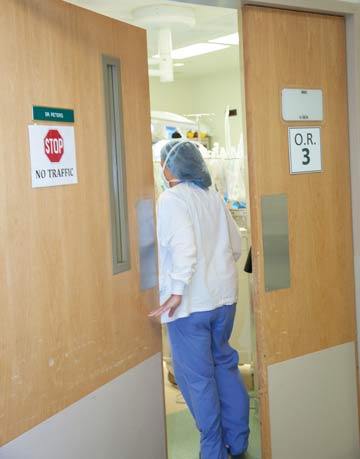Room turnovers are also a concern, especially because staff in many facilities who are under pressure to keep up with a packed surgical schedule rush through the process. Manual cleaning often isn't as deliberate or thorough as it should be,
and a lot of contaminants escape from surfaces and float into the air.
The surface disinfecting policies staff follow can therefore only do so much to rid ORs of harmful bacteria. That's where new technologies can supplement their efforts. The goal is to have some technology in place that removes airborne contaminants
as surgery is happening.
Here's a scary anecdote that brings home the need for this sort of background technology. A few years ago, there was a worldwide outbreak of Mycobacterium infections among cardiac surgery patients. It turned out that the heater-cooler systems
used during these procedures were delivered to hospitals already contaminated with pathogens, which were being transmitted through the air. There are also current concerns about forced-air warming units allegedly blowing contaminants off
of OR floors and into the surgical wounds of joint replacement patients.
These examples serve to illustrate that having a cleanliness-conscious staff alone won't always cover all of the bases for clean OR air. Having a device running in the background that constantly treats the air is essential.
Recently introduced air purification technologies include white light and UV-C light ceiling fixtures that replace traditional fluorescent lights in the OR. These lights continuously perform a small amount of disinfection during the day in
a passive manner. If you're building a new OR, or renovating an existing one, it makes sense to install these kinds of lights.
I'm also impressed by another new technology: a big, thin disk, almost like a wafer, that you place in your air handling system. As air passes through the disk, it turns into dry hydrogen peroxide — not vaporized, so it's nontoxic to
people. The disk treats air constantly, killing C. diff spores and other airborne contaminants.
Another neat technology that's getting traction, particularly in the orthopedic community, is a device that looks like a big ice machine. You wheel it into the OR, place it close to the sterile field, where it decontaminates air by sucking
it in and treating it with a HEPA filter and a UV light. Add these platforms to other technologies such as mobile horizontal laminar airflow systems and movable ultraviolet light rapid disinfectors, and the options for OR air cleaning
are rapidly expanding.
.svg?sfvrsn=be606e78_3)

.svg?sfvrsn=56b2f850_5)